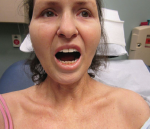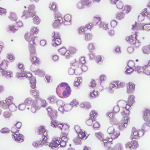“If you’re not routinely checking this, please check this antibody; it’s so important,” she said.
With limited scleroderma, patients often have Raynaud’s syndrome for years before other symptoms or recognition of disease, and skin thickening is usually limited to the fingers. These patients do not need treatment directed at the skin.
“We really need to avoid immunosuppression in most of these patients,” Dr. Hummers said.
Scleredema almost always starts at the back of the neck, on the upper back and around the shoulders, possibly progressing to the chest, back and upper arms. It feels what Dr. Hummers called “doughy” when you pinch it.
“It’s clear thick, but it feels doughier than scleroderma does,” she said. It most often occurs in the setting of poorly controlled Type 2 diabetes.
Eosinophilic fasciitis has a distribution in the extremities and the trunk but usually spares the hands and feet. Its skin quality is “woody” and deep, Dr. Hummers said.
“You should be able to pinch the skin but it feels thick under, so you can almost push the skin over this thickened fascia,” she said.
Peripheral eosinophilia can be found sometimes, but she cautioned this will disappear even with a bit of steroid treatment, so its absence doesn’t rule out eosinophilic fasciitis.
“If you see somebody who you know has morphea, you should really also kind of feel for eosinophilic fasciitis changes,” she said, because this may trigger treatment with corticosteroids. She also said there have been many reports of eosinophilic fasciitis after the use of checkpoint inhibitors.
Thomas R. Collins is a freelance medical writer based in Florida.
References
- Shen Z, Shao J, Sun J, Xu J. Exosomes released by melanocytes modulate fibroblasts to promote keloid formation: A pilot study. J Zhejiang Univ Sci B. 2022 Aug 15;23(8):699–704.
- Morgan N, Hummers LK. Scleroderma mimickers. Curr Treatm Op Rheumatol. 2016 Mar; 2(1): 69–84.


